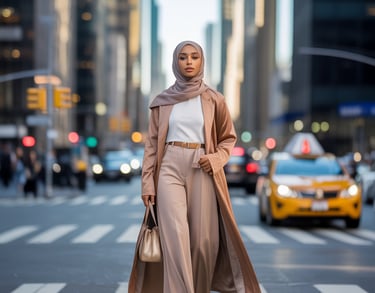Hijabi Influencers Are Redefining Global Fashion and Leading a Billion-Dollar Modest-Wear Movement
Discover how hijabi influencers are transforming the global fashion industry and reshaping modern style standards. From luxury brand partnerships to redefining runway trends, modest-fashion icons are proving that elegance, identity, and cultural pride belong at the heart of today’s fashion world. Explore the rise of modest wear as a billion-dollar movement, see how social media is accelerating representation, and learn why hijabi creators are becoming some of the most powerful voices in contemporary fashion.
FEMALE EMPOWERMENT
11/2/20252 min read


For decades, mainstream fashion revolved around a single vision of beauty. Today, a powerful shift is underway — one led by hijabi women who are redefining style, identity, and representation on a global scale. No longer confined to the sidelines, hijabi influencers are shaping trends, inspiring international brands, and proving that modest fashion is not a limitation but a sophisticated, modern expression of self. The modest-fashion industry is projected to grow by 40% this year, with market value expected to reach over $450 billion globally, driven largely by the rise of Muslim female creators who are making their voices — and style — impossible to ignore.
The transformation is most visible on social media, where hijabi creators have built massive loyal audiences. Look at influencers like Leena Snoubar (@withloveleena), whose soft-neutral aesthetic has inspired millions of modest fashion lovers worldwide, or Dalal Aldoub (@dalalid) from Kuwait, who became one of the first hijabi beauty influencers to collaborate with luxury houses. In the UK, Nabilah Kariem-Pecheco (@nabilahkariem) blends elegant layering with runway-level styling, while Dubai-based Marwa Hassan (@marwa.hassann) showcases how abayas can be modern, editorial, and powerful. These women are not just posting outfits; they are shaping conversations, guiding industry standards, and designing a global visual language for the modern modest woman.
What makes their influence so impactful is the combination of fashion credibility and cultural authenticity. Instead of bending to traditional Western beauty standards, hijabi icons are building new ones. Dior, Burberry, and Chanel have all collaborated with Muslim creators in the past three years, and luxury brands are incorporating covered silhouettes, longer hemlines, and fluid tailoring into seasonal collections. Even global retailers are responding — Nike and Adidas launched modest sportswear lines, while H&M and Uniqlo introduced hijab-friendly collections. When a single hijabi influencer’s product mention can sell out items across multiple regions — something reported in several case studies — it becomes clear the industry is paying attention.
The appeal extends beyond fashion. For many followers, these creators represent confidence, cultural pride, and identity in a world that often misunderstands their choice to cover. They show how a tailored wool coat layered over a silk abaya can look as luxurious as any Paris Fashion Week look. They experiment with soft-matte makeup, structured silhouettes, monochrome layering, and delicate jewelry to reflect elegance and strength. And they do so while centering values like dignity, privacy, and self-respect — a message many young Muslim women say inspires empowerment, not restriction. This blend of modern luxury and cultural confidence is what makes the movement so influential.
Of course, the rise of hijabi visibility has not come without challenges. The fashion and beauty industry still struggles with tokenism and inconsistency. Some brands showcase hijabi models during Ramadan, only to exclude them for the rest of the year. Others offer limited size-inclusive or culturally sensitive options. Despite this, the momentum continues to grow, and creators are building independent success through brand partnerships, product lines, and global campaigns. If the current trajectory continues, the next few years will likely bring more modest fashion weeks, expanded luxury collaborations, and Muslim-founded global brands entering the mainstream.
This movement is not simply about clothes — it is about redefining representation. It is about a new generation of women saying, “I choose my identity, and I choose fashion — on my terms.” Hijabi influencers are not changing to fit the fashion world; instead, they are changing fashion itself. And as the market continues to expand across the Middle East, Southeast Asia, Europe, and North America, one thing is clear: modest fashion is not a trend. It is a global, premium, and powerful reimagining of what style can look like.
The fashion future is diverse, elegant, and unapologetically modest — and hijabi women are leading that future with grace, creativity, and purpose.
